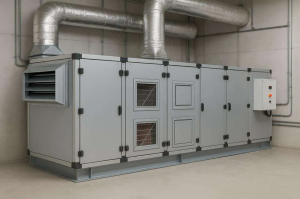How Air Handling Unit (AHU) Setup Affects Indoor Air Quality
Indoor air quality (IAQ) plays a critical role in the health, comfort, and productivity of building occupants. One of the key systems that directly influences IAQ is the Air Handling Unit (AHU). The way an AHU is designed, installed, and maintained can make the difference between a clean, healthy indoor environment and one that contributes to discomfort or illness.

AHUs are equipped with filters that trap dust, pollen, microorganisms, and other airborne particles. The type and efficiency of filters used such as MERV-rated or HEPA filters determine how effectively contaminants are removed from the air. High-quality filters improve air cleanliness and protect occupants from allergens. Clogged or poorly maintained filters reduce system efficiency and allow pollutants to recirculate.
Ventilation and Fresh Air Intake also affects the indoor air quality. AHUs control the balance between recirculated indoor air and fresh outdoor air. Proper ventilation dilutes indoor pollutants such as carbon dioxide (CO₂), volatile organic compounds (VOCs), and odors. A well-set fresh air intake is needed to ensure adequate air exchange. Poorly located intakes, however, can draw in outdoor pollutants such as car exhaust, industrial fumes or nearby building emissions.
Maintaining the right humidity levels is another key function of the AHU. Cooling coils and humidifiers work together to keep relative humidity between 40–60%, which is considered optimal for health and comfort. When relative humidity is too low or dry, it can cause skin irritation, respiratory discomfort, and static electricity. Conversely, when relative humidity is too high, it can encourage mold growth, unpleasant odors, and microbial contamination.
Temperature balance across the building. Air distribution from the AHU ensures consistent temperature across different zones of a building. Poorly balanced setups may cause hot and cold spots, creating discomfort for occupants and negatively influencing their perception of air quality.
Even with a well-functioning AHU, duct design and cleanliness play a big role in IAQ. Proper air distribution and ductwork is needed to ensure the AHU is functioning at optimum conditions. Leaks, dust buildup, or microbial growth in ducts can reintroduce pollutants into the air. Poor airflow distribution can also result in stagnant areas with inadequate ventilation.
Regular maintenance is essential for ensuring an AHU contributes positively to indoor air quality. Standing water in drain pans, dirty coils, or biofilm growth inside the unit can all become sources of mold and bacteria that spread through the air supply. Regular checking is needed to ensure all equipment can be maintained working accordingly.
The setup and maintenance of an AHU directly influence indoor air quality. By ensuring proper filtration, balanced ventilation, humidity and temperature control, clean air distribution, and regular upkeep, building managers can create a healthier, more comfortable environment for occupants. A well-managed AHU doesn’t just protect health instead it also boosts productivity, enhances occupant satisfaction, and extends the lifespan of HVAC systems.
Megajana can give a free consultation on your AHU setup. Contact us here to know more!